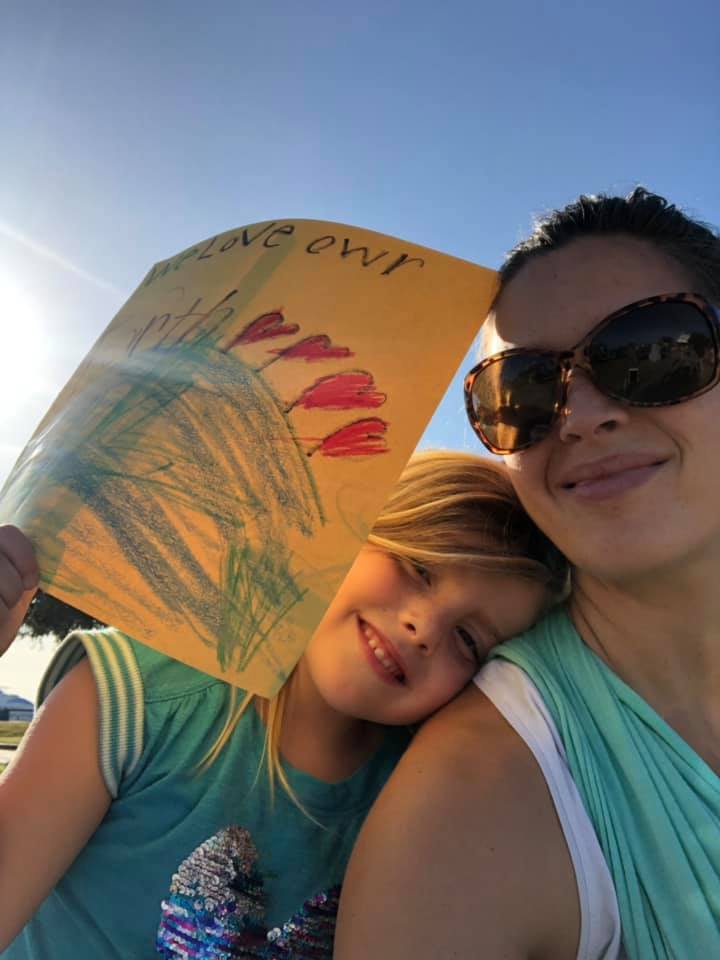When I was in 4th or 5th grade, I was cast as one of the leads in the school play. The play was called “Assignment: Earth” and it was an elementary school musical teaching about climate change and what we, as kids, could do about it.
This is what kicked off my journey as a climate change activist.
I grew up with some of these ideas already planted in my brain. My dad has worked in the recycling industry for years. He even once dressed up as a recycling superhero for Halloween. So we always recycled. And we had a compost pile.
But it was acting in Assignment: Earth that really sealed the deal for me.
After that I was committed to doing everything I could to protect and fight for the future of this planet.
Almost 30 years later, I am more committed to actions that combat climate change than ever.
I’m a mother and I want my kids to have a future on this planet that isn’t terrifying. I want their kids and their kids and their kids to have the same.
Some days it feels as though the issues facing this planet are more than any one person can handle. Like no matter what we do, nothing will actually make a difference.
The thing is, that’s not true. It’s flawed logic because if EVERYONE did lots of small things, we’d see massive change.
Here are 5 Simple Ways to Combat Climate Change
Eat Less Meat
People get a little tweaked out whenever it’s suggested that they cut back on meat. I usually hear this to the tune of, “but I do meatless Mondays” or “but I don’t know what else to eat” or “I need all of the protein to truly LIVE!”
Meatless Mondays are a great start. What about Meatless Mondays, Wednesdays, and Fridays? Or Meatless Weekends? Or giving up meat altogether?
And there are loads of other things to eat. They are called plants and they are delicious. Incidentally, plants also contain protein. Enough for you to live.
Here’s why giving up meat or eating less of it is so important:
In August, fires raged throughout the Amazon. These were primarily man-made fires set to clear land for cattle ranching.
Most of the beef raised and slaughtered there is sold around the world, not just locally in Brazil. And it’s sold to places like Burger King and Walmart.
The Amazon rainforest is irreplaceable. And acts as the lungs of our planet. Right now, our lungs are burning. And the smoke is impacting air quality, not to mention helping raise the temperature of the planet.
There are people who physically cannot give up meat. Or people who aren’t ready to go meat-free.
The solution is to be more mindful and aware of where you buy your meat. Avoid Walmart, Burger King, and other fast food/big box stores. Do your research and buy your meat locally, grassfed, and organic.
Eating less meat will absolutely help combat climate change.
Buy Local
We’ve gotten really accustomed to buying everything online and this is a huge problem. I mean, I get it. Online shopping has added convenience to our lives and freed up time we would have spent at the grocery store/clothing store/any store, not to mention in the car.
So convenient, yes. Unfortunately, shipping methods are still super high carbon emission endeavors.
Buying locally, whether it’s food or other goods, is beneficial for the environment and also for the local economy. Amazon doesn’t need your money. That local bookstore does, though.
Plus, a lot of times when you’re buying from a big online company, the product goes through several shipping routes before getting to you. And, unless you do big groups of purchases all at once, often you get lots of little boxes, delivered all week long. Not super efficient.
If more people bought products locally, we’d definitely make an impact.
Drive Less, Walk More
I know this isn’t an easy one. Especially if you live in the suburbs, like I do.
Thing is, one of my local grocery stores is less than a mile away. And right next to it, a Lowe’s. If I plan it into my day, I can walk there in 15 minutes. I can bring a backpack or a cart to haul everything back. If the things I’m purchasing are cold, I can pack ice packs in my backpack.
Since this isn’t realistic or possible for everyone, the alternative is to coordinate your errands more intentionally. I usually do my food shopping on a day when I am either in the big city close to my house or when I am teaching a yoga class that is closer to the city. So I’m already halfway there.
If I have errands to run that are close together — bank, post office, library for example — I make sure I plan ahead the extra time and have everything I need when I leave the house. A little planning can go a long way.
For what it’s worth, this is a lot easier for most people than the suggestion of buying an electric car, which is usually at the top of most “5 simple ways to combat climate change” lists. Electric cars aren’t affordable for most people yet.
So for now, do the smaller thing. Drive less, walk more. Or coordinate your errands so you are driving less.
Use Things Up
We’ve gotten into some bad habits when it comes to consumerism.
It’s really easy to replace things whenever we want, so we do.
Those boots are “so last season.” Time to get new ones!
New school year! Time for a new backpack and lunchbox and school clothes.
I don’t have the newest iPhone. Gotta replace it ASAP!
We don’t use things to their capacity anymore. We replace things when we get bored with them. This fills up landfills faster and gives us the idea that everything is replaceable, including this planet.
Ok, maybe I’m being a little dramatic. But when was the last time you wore your shoes until you got holes in the soles? When was the last time you repaired a hole in a pair of beloved jeans?
Another way to think of this is that we tend to buy things that are more cheaply made because they are less expensive. They also tend to not last as long, so we have to replace them sooner.
Spoiler alert: that’s the point. You’re not really saving money if you’re actually replacing things that wear out faster.
So buy quality items that you love that will last.
And when your favorite shirts do break down, turn them into rags and extend their life even further!
Use Less Plastic
Listen, plastic is not evil. Plastic is just overused.
It also doesn’t easily biodegrade.
And as awesome as recycling is, it’s not a long term solution. Especially since 90% of plastic that is produced isn’t recycled.
You’ve probably already heard that China won’t take our recycling anymore. And Malaysia and Thailand won’t either.
Recycling isn’t sustainable, especially for plastic, so we need to start using less.
I get that this is a hard pill to swallow. We rely on plastic for a lot of things. It’s also really easy to avoid, once you get the hang of it. You can check out some of my tips from my Ditch Your Plastic Bag Habit blog.
You can also look for products that you might get in plastic, like oil or noodles, in glass or cardboard. Avoid plastic straws and plastic drink containers. Bring your cloth bags everywhere.
You can look for more sustainable alternatives in pretty much everything you buy.
The point is that you can choose to purchase alternatives to plastics. You just have to do some research and plan ahead, which is my opinion, is worth it if it helps the planet.
Need a few more ideas? Here are another 5 Simple Ways to Combat Climate Change!
✔ Keep your house at a higher temperature during the summer and a lower temperature during the winter.
✔ Use water more responsibly: Take fewer showers. Run full loads of laundry and dishes.
✔ Throw away less food. Compost if you can.
✔ Less “Wish-cycling” — when you throw in items that cannot be recycled, you can damage an entire batch and more ends up in the landfill.
✔ When you need to, update your appliances to more environmentally-friendly models.
Anything you’d add to my 5 simple ways to combat climate change? Let me know in the comments below!
***************
And if you’d like some ways celebrate encourage your kids to become little climate activists like I was, I’ve got a FREE Tip sheet for that!
Download my free tip sheet for earth-friendly activities you can do with your kids all year round!



